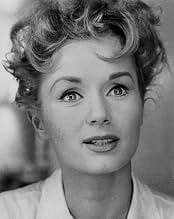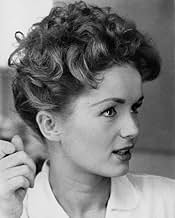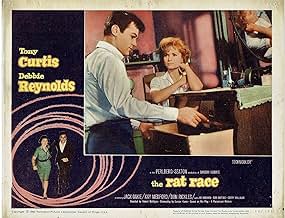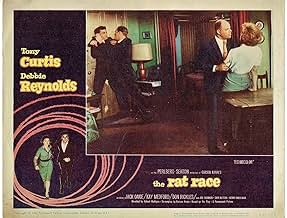Ajouter une intrigue dans votre langueAn aspiring musician arrives in New York in search of fame and fortune. He soon meets a taxi dancer / call girl and moves in with her. Before long, a romance develops.An aspiring musician arrives in New York in search of fame and fortune. He soon meets a taxi dancer / call girl and moves in with her. Before long, a romance develops.An aspiring musician arrives in New York in search of fame and fortune. He soon meets a taxi dancer / call girl and moves in with her. Before long, a romance develops.
- Réalisation
- Scénario
- Casting principal
- Cab Driver
- (non crédité)
- Diner Patron
- (non crédité)
- Member of the Red Peppers
- (non crédité)
- Hotel Guest
- (non crédité)
- Ship Passenger
- (non crédité)
- Hotel Clerk
- (non crédité)
Avis à la une
try to overlook the residue of Tonys Bronx accent - and enjoy his eager Midwestern saxophonist arriving in the jazz musicians mecca - Noo Yawk City
except he's not in a typical Hollywood success story - here the emphasis is on disillusionment - and its actually risqué for its time - with Tony and struggling dancer Debbie Reynolds sharing an apartment - both actors are very good - Debbie could have used more such roles
the script is too talky perhaps - too much like a stage play - the most memorable thing for me beside the stars is the music - especially the throbbing theme song played over the opening scenes of Tony's cross country bus ride - from the plains of the Midwest - to smog shrouded NYC
and i can still hear in my mind the driving version of THAT OLD BLACK MAGIC played with real life saxophonists Sam Butera and Jerry Mulligan - and Joe Buskin at the keys - that scene demonstrates how convincing Curtis was at faking playing a saxophone - notice his red face while playing the large baritone sax - when i was in the school band - i could barely get a sound out of one of them
Maybe this will help: Tony Curtis is himself, really strong, and if you like him, you'll like him. Debbie Reynolds is kind of at her best, for me, less trivial than she is sometimes portrayed. She doesn't dance or sing, but is just a girl trying to make it in New York. Throw in Don Rickles at an exaggerated but believable role, with less humor and more grotesqueness. Finally, though big sax man Gerry Mulligan gets big letters in the credits, he appears, as himself, only briefly (though we do get to hear him play for a few seconds).
But let's turn this around and talk plot. In a very broad way, this is a kind of "Breakfast at Tiffany's" a year earlier. Nice guy lands in New York without a clue and local woman is braving it on her own and having to compromise her principles in the process. Even the music, by Elmer Bernstein, is in a Henry Mancini style (only rarely dipping into any real jazz, for those looking for that). Though painted as a story of boy meets girl and the improbable follows the unlikely, the basic premise is heartwarming and true to a lot of our dreams of making it, and making it with the right person (both).
I liked this movie a lot. It's even photographed by Alfred Hitchcock's cinematographer, Robert Burks, and so it looks good, too, in mildly widescreen Technicolor. It's a situation drama/comedy--there is no sensing that this is actually real. In that sense it's really a 1960 era movie, when artifice had reached a truly plastic kind of height (sometimes with wonderful results, but even classics like, say, "West Side Story" have a style from the times that is neither classic 1940s Hollywood in its believability nor totally creative invention as with those rare movies here and there all through the decades). The point is, you have to like this kind of set-up style to start with. You probably know whether movies like some of the Doris Day classics or even Marilyn Monroe movies are up your alley.
Or "Breakfast at Tiffany's," or the black and white counterpart in a different sense, "The Apartment." I think this Curtis/Reynolds romantic comedy is totally overlooked, and deserves a close look. There are ever some fabulous if fleeting shots of busy New York City. And if you've never heard of the director, Robert Mulligan (no relation to Gerry), don't worry. He did pull off one all time classic handled with similar panache--"To Kill a Mockingbird." Yeah, don't underestimate this one.
Curtis takes pity on Reynolds and invites her to share his flat--but his luck fades when his musical instrument is stolen. True love blossoms as Reynolds tries to help him with lots of obstacles thrown in their way by assorted no-gooders.
Garson Kanin directed from his play and he keeps the action moving and the stylish backgrounds show New York City scenes that would make any New Yorker nostalgic for "the way it was".
A downbeat, sometimes bitter dose of comedy/drama that has so much energy and such appealing performances from Reynolds and Curtis, that you'll be drawn into it from the start. Well worthwhile.
Norman Fell and Don Rickles were very effective as the "heavies". To this day, I think of Don Rickles as "Nellie" in this film. I'm a Rickles fan, but can't make myself like him (smile).
Also love the NYC scenes, and film is almost nostalgic (NYC, the way it was in 1960).
Definitely a "must see". Great actors in their environment and in a past era. I have a VHS tape, but will order a DVD as soon as I log off :-) Tim
Le saviez-vous
- AnecdotesElmer Bernstein, the film's composer, has an unaccredited role as a member of a jazz band called The Red Peppers. Bernstein is the man in the red shirt who wears sunglasses.
- Citations
Mac, Owner of Macs Bar: Ah don't sweat honey, perfectly normal. Half the world is looking for the other half, did you ever notice it? Just consider, buyers and sellers trying to meet up, and visa versa. Crooks lookin' for suckers, boys for girls. Tops for bottoms and bottoms for tops, very interesting - no end. Jobs lookin' for people, people lookin' for jobs... or for trouble. Ah no hon, it's nothin' to be ashamed of.
- ConnexionsFeatured in Mr. Warmth: The Don Rickles Project (2007)
Meilleurs choix
- How long is The Rat Race?Alimenté par Alexa
Détails
- Date de sortie
- Pays d’origine
- Langue
- Aussi connu sous le nom de
- La taberna de las ilusiones
- Lieux de tournage
- Philadelphie, Pennsylvanie, États-Unis(Exterior)
- Sociétés de production
- Voir plus de crédits d'entreprise sur IMDbPro
Box-office
- Montant brut aux États-Unis et au Canada
- 7 412 000 $US
- Durée
- 1h 45min(105 min)
- Rapport de forme
- 1.33 : 1(original ratio)

































